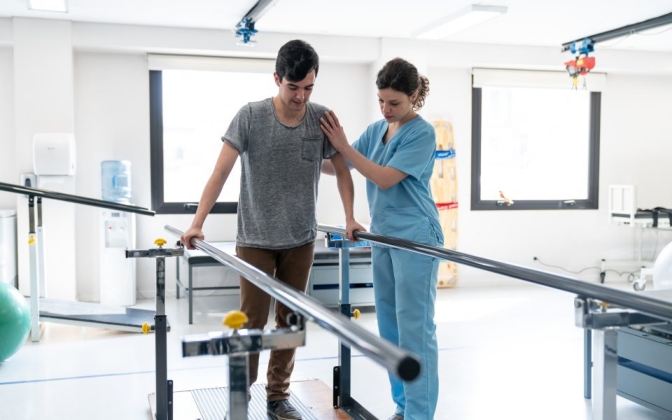
Parkinson’s disease (PD) is a progressive neurodegenerative disorder characterized by motor symptoms such as tremors, rigidity, bradykinesia (slowness of movement), and postural instability, as well as non-motor symptoms like cognitive impairment, depression, and fatigue. Neuro rehabilitation plays a critical role in managing Parkinson’s symptoms, improving quality of life, and maintaining independence. By utilizing a combination of therapies and targeted interventions, individuals with Parkinson’s can address both physical and non-physical challenges associated with the disease.
Importance of Neuro Rehabilitation for Parkinson’s Disease
Parkinson’s disease affects not only motor functions but also balance, coordination, speech, and emotional well-being. Rehabilitation strategies focus on:
- Improving motor function and reducing stiffness
- Enhancing balance and coordination
- Preventing falls and increasing mobility
- Supporting speech, swallowing, and cognitive functions
- Reducing fatigue and depression
Therapies are tailored to each individual’s symptoms, disease progression, and unique goals.
Strategies and Techniques in Neuro Rehabilitation for Parkinson’s Disease
- Physical Therapy
Role:
Physical therapy aims to improve mobility, flexibility, balance, and strength. A physical therapist assesses the patient’s condition and develops a personalized plan focusing on exercises to address rigidity, tremors, and bradykinesia.
Common Techniques:
- Stretching and Flexibility Exercises: These exercises help reduce muscle stiffness, improve range of motion, and enhance posture.
- Strength Training: Weight-bearing exercises target muscle weakness and improve overall strength.
- Balance Training: Activities like standing on one leg or using a balance board help reduce the risk of falls.
- Aerobic Exercise: Activities like walking, cycling, and swimming improve cardiovascular health, stamina, and overall well-being.
- Gait Training: Therapists may use cues like rhythmic auditory stimulation (e.g., metronome beats or music) to improve walking patterns and overcome freezing episodes.
- Occupational Therapy
Role:
Occupational therapy (OT) focuses on improving the patient’s ability to perform daily activities independently, such as dressing, bathing, cooking, and managing household tasks. An occupational therapist evaluates the individual’s home environment and recommends adaptive strategies and assistive devices.
Common Techniques:
- Task Simplification: Breaking down tasks into smaller, manageable steps to conserve energy and reduce frustration.
- Assistive Devices: Using tools such as weighted utensils, dressing aids, and non-slip mats for improved independence.
- Hand Therapy: Exercises that focus on improving dexterity and grip strength to assist with fine motor tasks.
- Speech and Language Therapy
Role:
Parkinson’s disease often affects speech, swallowing, and communication abilities. Speech therapists help patients regain their voice volume, clarity, and control, as well as address swallowing difficulties.
Common Techniques:
- Lee Silverman Voice Treatment (LSVT LOUD®): A widely used speech therapy program focused on increasing vocal loudness and improving communication.
- Articulation Exercises: Targeting clarity and precision in speech production.
- Swallowing Therapy: Techniques to address dysphagia (difficulty swallowing), such as posture adjustments and exercises to strengthen swallowing muscles.
- Cognitive Rehabilitation
Role:
Many individuals with Parkinson’s experience cognitive changes, such as memory problems, reduced attention, and slowed thinking. Cognitive rehabilitation helps patients improve or maintain cognitive function through structured activities and exercises.
Common Techniques:
- Memory Training Games: Activities to improve recall, attention, and processing speed.
- Problem-Solving Exercises: Tasks to enhance planning, organization, and decision-making skills.
- Compensatory Strategies: Using tools like calendars, to-do lists, and digital reminders to aid daily functioning.
- Exercise Programs Tailored for Parkinson’s Disease
Regular exercise has proven benefits for individuals with Parkinson’s, helping to manage symptoms and potentially slowing disease progression. Structured exercise programs include:
- Yoga and Tai Chi: These practices improve flexibility, balance, and relaxation, while also reducing stress and promoting mindfulness.
- Dance Therapy: Programs like dance for PD® offer dance-based exercises that improve balance, coordination, and social connection in a fun, engaging setting.
- Boxing Therapy: Non-contact boxing classes (e.g., Rock Steady Boxing) target endurance, agility, and coordination while providing camaraderie and motivation.
- Deep Brain Stimulation (DBS) and Rehabilitation
For some patients, deep brain stimulation (DBS) surgery may be recommended to help control motor symptoms that are not adequately managed with medication. Rehabilitation following DBS focuses on optimizing the patient’s abilities and adjusting to changes in symptom management.
- Multidisciplinary Care and Patient Support
Parkinson’s disease requires a multidisciplinary approach involving neurologists, physiotherapists, occupational therapists, speech therapists, dietitians, social workers, and mental health professionals. This comprehensive team ensures that all aspects of a patient’s condition are addressed, from motor symptoms to emotional and social challenges.
Tips for Effective Neuro Rehabilitation in Parkinson’s Disease
- Stay Active: Regular participation in physical activities tailored to individual abilities helps manage symptoms and promotes well-being.
- Consistency Is Key: Following therapy recommendations and home-based exercises consistently is essential for maintaining and enhancing progress.
- Monitor Medication Timing: Collaborate with healthcare providers to ensure therapies are scheduled around optimal medication times for maximum mobility and alertness.
- Involve Caregivers and Family: Caregivers play a crucial role in offering encouragement, providing assistance, and reinforcing therapy strategies at home.
- Use Visual and Auditory Cues: Incorporating cues can help overcome movement difficulties, such as freezing episodes.
- Focus on Nutrition and Hydration: A balanced diet and adequate hydration can reduce fatigue, constipation, and other non-motor symptoms.
Conclusion
Neuro rehabilitation for Parkinson’s disease involves a broad range of strategies and techniques tailored to individual needs. From physical therapy to cognitive and speech interventions, the goal is to enhance mobility, improve daily functioning, and support patients in living fuller, more independent lives. At The Physio9 Clinic, we specialize in Neuro Rehabilitation treatment in Pune, offering personalized therapy programs, regular exercise plans, and caregiver support to help individuals with Parkinson’s better manage symptoms, maintain their independence, and improve their overall quality of life.







